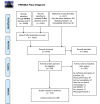What's in a name? Unpacking 'Community Blank' terminology in reproductive, maternal, newborn and child health: a scoping review
- PMID: 36750272
- PMCID: PMC9906186
- DOI: 10.1136/bmjgh-2022-009423
What's in a name? Unpacking 'Community Blank' terminology in reproductive, maternal, newborn and child health: a scoping review
Abstract
Introduction: Engaging the community as actors within reproductive, maternal, newborn and child health (RMNCH) programmes (referred to as 'community blank') has seen increased implementation in recent years. While evidence suggests these approaches are effective, terminology (such as 'community engagement,' 'community participation,' 'community mobilisation,' and 'social accountability') is often used interchangeably across published literature, contributing to a lack of conceptual clarity in practice. The purpose of this review was to describe and clarify varying uses of these terms in the literature by documenting what authors and implementers report they are doing when they use these terms.
Methods: Seven academic databases (PubMed/MEDLINE, Embase, CINAHL, PsycINFO, Scopus, Web of Science, Global Health), two grey literature databases (OAIster, OpenGrey) and relevant organisation websites were searched for documents that described 'community blank' terms in RMNCH interventions. Eligibility criteria included being published between 1975 and 1 October 2021 and reports or studies detailing the activities used in 'community blank.' RESULTS: A total of 9779 unique documents were retrieved and screened, with 173 included for analysis. Twenty-four distinct 'community blank' terms were used across the documents, falling into 11 broader terms. Use of these terms was distributed across time and all six WHO regions, with 'community mobilisation', 'community engagement' and 'community participation' being the most frequently used terms. While 48 unique activities were described, only 25 activities were mentioned more than twice and 19 of these were attributed to at least three different 'community blank' terms.
Conclusion: Across the literature, there is inconsistency in the usage of 'community blank' terms for RMNCH. There is an observed interchangeable use of terms and a lack of descriptions of these terms provided in the literature. There is a need for RMNCH researchers and practitioners to clarify the descriptions reported and improve the documentation of 'community blank' implementation. This can contribute to a better sharing of learning within and across communities and to bringing evidence-based practices to scale. Efforts to improve reporting can be supported with the use of standardised monitoring and evaluation processes and indicators. Therefore, it is recommended that future research endeavours clarify the operational definitions of 'community blank' and improve the documentation of its implementation.
Keywords: Health systems; Maternal health; Paediatrics; Public Health; Review.
© Author(s) (or their employer(s)) 2023. Re-use permitted under CC BY-NC. No commercial re-use. See rights and permissions. Published by BMJ.
Conflict of interest statement
Competing interests: None declared.
Figures





References
-
- WHO W . People-centred health care: a policy framework. Geneva: World Health Organization, 2007.
-
- Organization WH . Primary health care: declaration of alma-ata international conference on primaryhealth care. Alma-Ata, 1978.
-
- George AS, Mehra V, Scott K, et al. Community participation in health systems research: a systematic review assessing the state of research, the nature of interventions involved and the features of engagement with communities. PLoS One 2015;10:e0141091. 10.1371/journal.pone.0141091. - DOI - PMC - PubMed
Publication types
MeSH terms
Grants and funding
LinkOut - more resources
Full Text Sources
Medical
